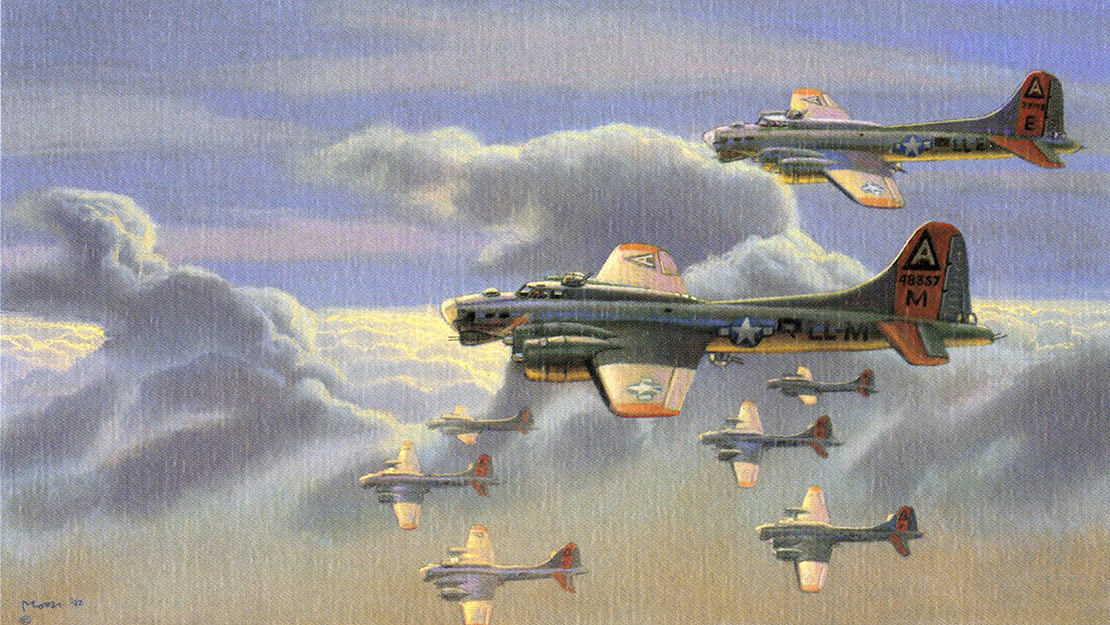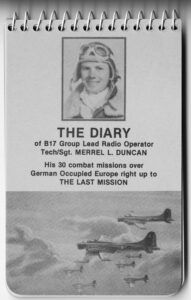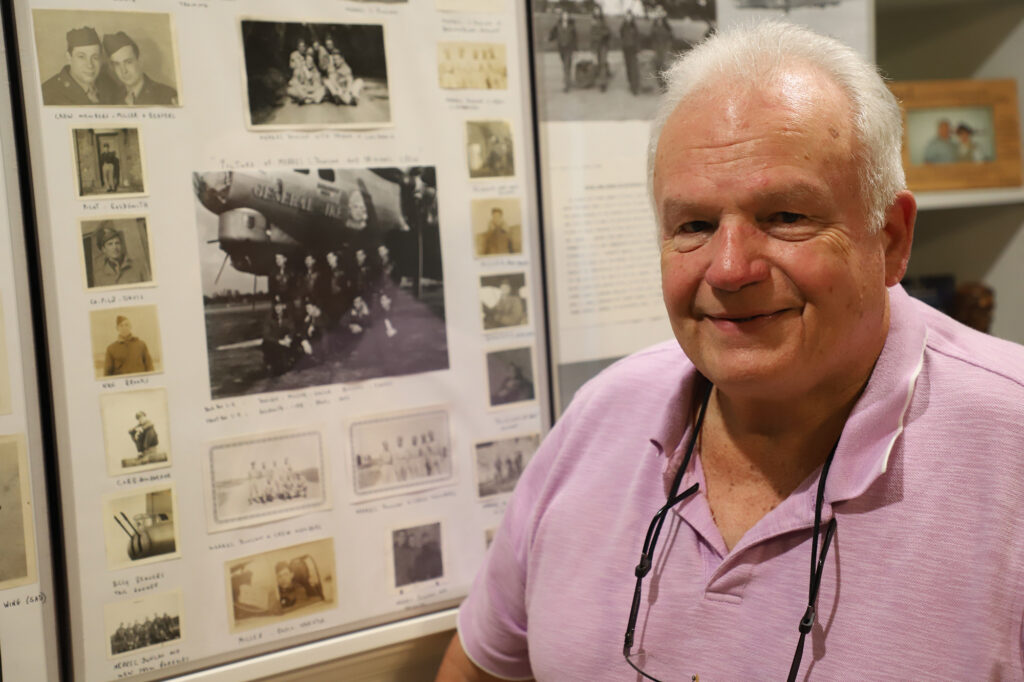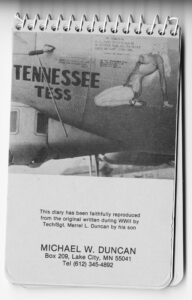Son keeps father’s legacy alive

RED WING — It’s 1944. Radio operator Merrel L. Duncan of Dundee has returned from a mission aboard a B-17 Flying Fortress. He is back at his quarters at Bassingbourn in England, writing in his diary.

“Aug. 16. Target for today was a factory 3 1/2 mi. N.E. of Leipzig. It manufactured wings for Ju88s. We carried 10 500# clusters of incendiaries. We bombed from 24,000’ temp -20◦C. Flak was encountered quite heavy in spots, but at the target, we didn’t get much. On oxygen for 6 1/2-7 hours. Almost all our oxygen was used up by the time we got back. We got enemy fighters for our first time since I started flying. We were in heavy flak + all of a sudden the flak stopped + bandits hit. They hit the ships in the high element right in back of us + to the left. There were ME 109s + FW 190s [Messerschmitt Bf 109 fighters and Focke-Wulf Fw 190 fighters]. They just laid up there + peeled off into the B-17s. I think the gunners were caught unaware because there was hardly a shot fired from the ships that went down. One ME 109 came past at 90◦, + I fired about 150 to 200 rounds, so did Muscles + Umlor. He peeled over + went under our ship + exploded. They made just one pass, it lasted about 50 sec. if that long. On the one pass they got 8 of our B-17s. I saw one B-17 blow up another, another go down in flames, 2 others drop out of formation all afire. I saw one chute bail out delayed jump. Another looked like the fellow was almost gone. He hung like a rag doll. When we got back to the base we found out that Lt. Goods crew was one of the crews that was hit but he made it back. Their oxygen was shot out + they were at 24,000’. The 324 Squadron lost 7 ships + have only a few crews left. Pine bailed out over Germany + just before he went he called + said he was shot up bad so was going out. Tyson, got killed 2-20 mm in the head + 1 in the neck. Peters, got 1-20 mm in the ankle. He’s in Cambridge Hospital at the present. They got back to this side but crash landed in Southern England. I never was so all in + shaken up in my life. I’ve Prayed every day that I’ve been here + I know it’s the Lord who has seen us through this far. As I write date Aug. 16, 1944, for the first time today. I realize that this date is my 28th birthday + I’ve been given Grace by our Supreme Father to live.”
Airman Duncan, a graduate of Fulda High School, survived 30 missions over Europe in World War II, with the 91st Bomb Group, 401st Squadron, based in Eastern England at RAF Bassingbourn. They were known as “The Ragged Irregulars.”
In its first seven months of action, the 91st Bomb Group suffered 82 percent casualties and lost 41 of its original 48 aircraft. Duncan was among the few to survive. He recorded all of his missions in a small, 60-page, spiral-bound diary.
He began serving as a radio operator aboard the “General Ike” B-17. After a time, he became group lead radio operator, serving aboard various bombers. His last mission was aboard the “Tennessee Tess.” He was a technical sergeant (E-6) by this point.
“Dad was always calm no matter how crazy and wild it got,” said his son, Michael, who lives in Red Wing. “That was what was amazing about him.”
Michael Duncan works to keep his father’s legacy alive all these years later. Michael himself is a Vietnam veteran and a member of Red Wing American Legion Post 54.
After his father’s death on Nov. 16, 1989, son Michael Duncan read the diary for the first time. He had it reprinted in handwritten fashion as a limited edition on spiral-bound notebooks for the public to consume. It is titled “The Last Mission.”
For four years in the late 1980s and early 1990s, Duncan combed the country talking to media outlets to find the aircraft called Tennessee Tess. He found a fellow in Florida who had flown with his father. The man had a photo of the aircraft. Duncan used the photo to prove its existence to federal authorities and historical societies. That photo is on the back of the reprinted diary.
The aircraft ended up in a boneyard and scrapped.

Duncan himself served in the Air Force, with the 9th Reconnaissance Wing, mainly flying into weather systems ahead of fighter groups. He was part of the crew on WC-130s. He served from January 1969 to January 1973. After he got out, he had a hard time getting a VA claim, but a woman working as a county veteran service officer helped him stick with it, and he won his claim.
“I owe her a debt of gratitude,” he said. “It’s a different VA now than it was back then.”

Duncan commissioned artwork in his father memory and, in November 1992, was part of a signing ceremony in Lake City. Called “The Last Mission,” its artist is Bryan Moon. With them was retired Capt. R.R. Goldsmith, group lead pilot.
Duncan sells the limited prints to American Legion and VFW posts for $100. The print normally costs $150. It hangs in the entrance to the VA Medical Center in Atlanta. You can find one in at Post 54 in Red Wing. There is now one at The American Legion Department of Minnesota, too.
Contact him at mikeduncan4653@gmail.com if your post wants one.
Merrell Duncan was from a family of five brothers and five sisters. His brother Earl was drafted. Earl was married, so Merrell — whose nickname was “Squirt” — volunteered to take his place. Squirt married his wife, Bonnie, in Fort Ord, Calif., before shipping out. She was from Heron Lake.
He arrived at Bassingbourn on July 2, 1944, and completed his tour on Jan. 1, 1945.


